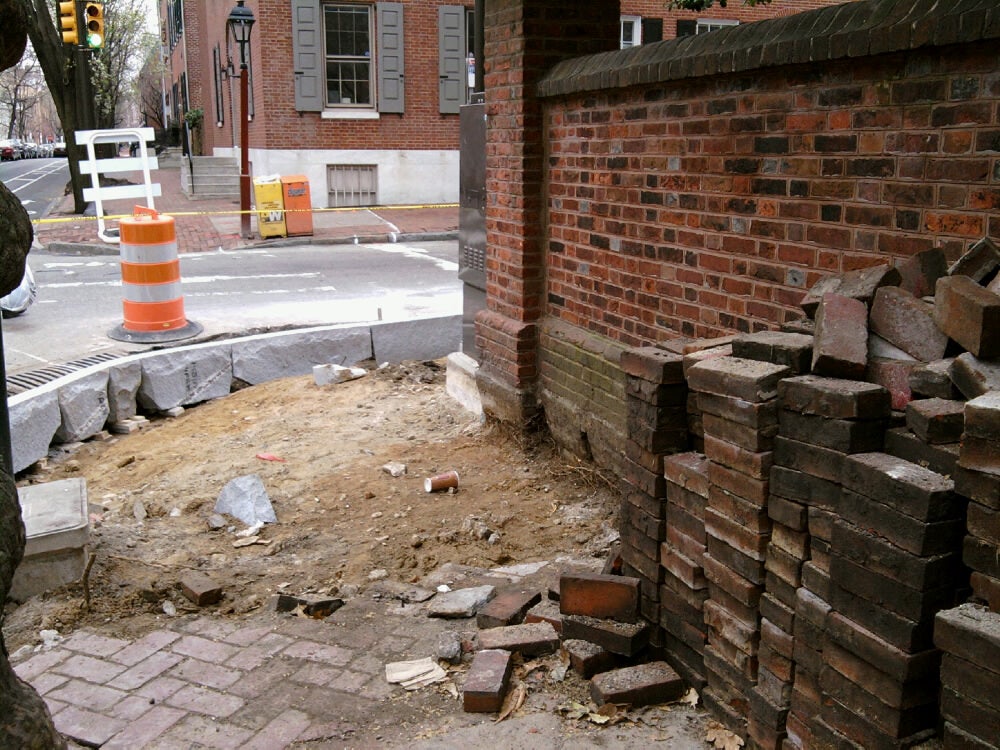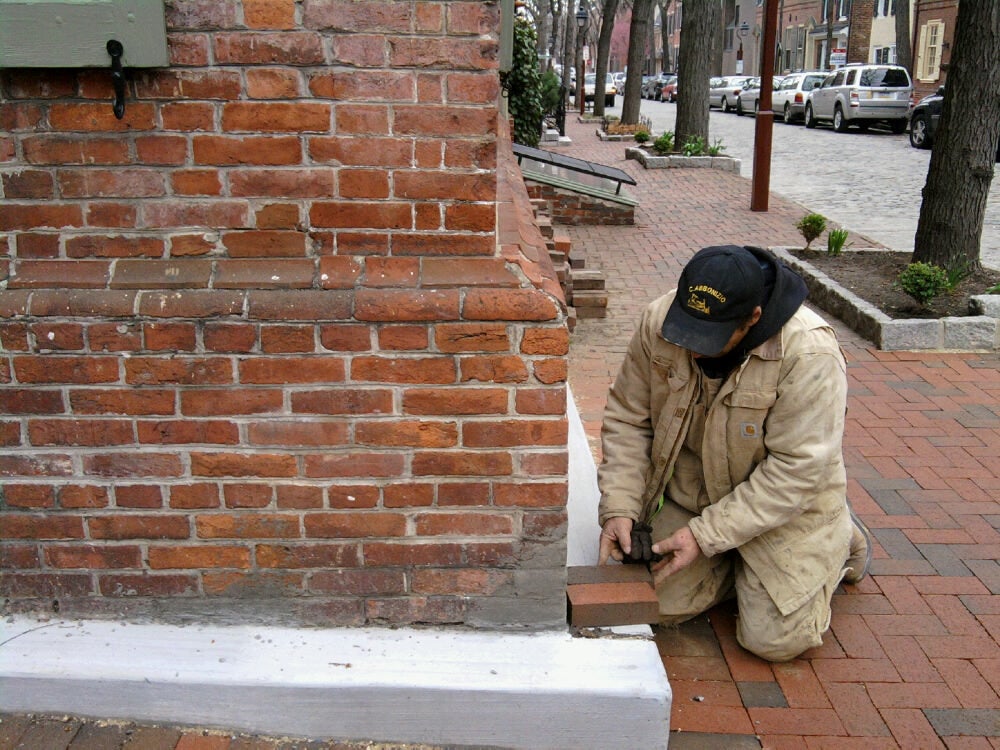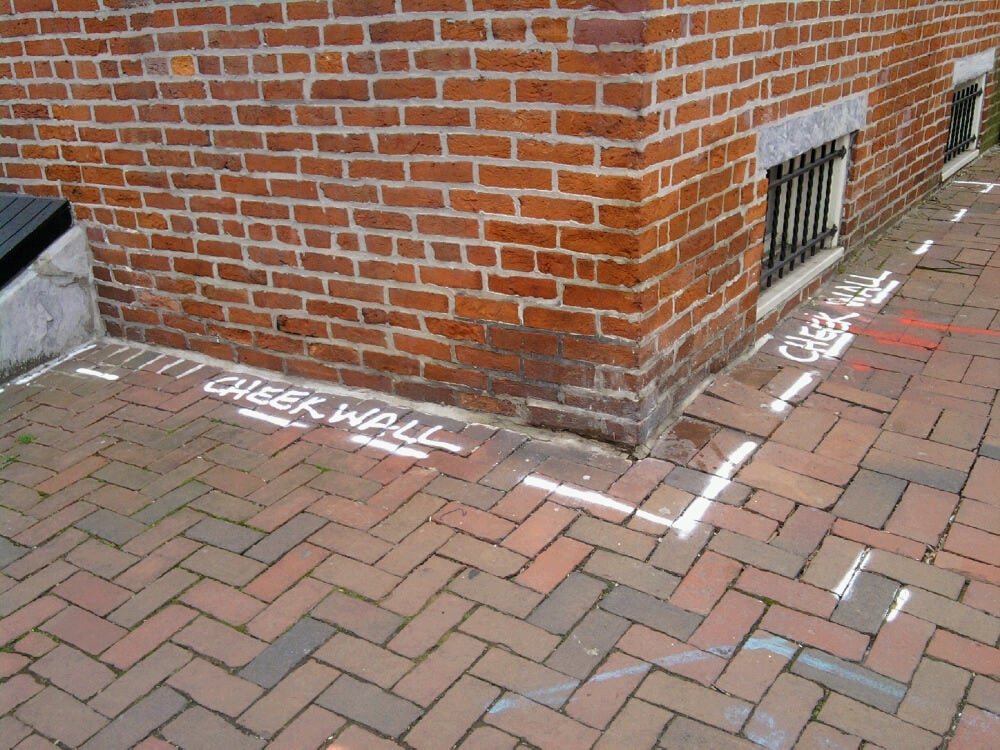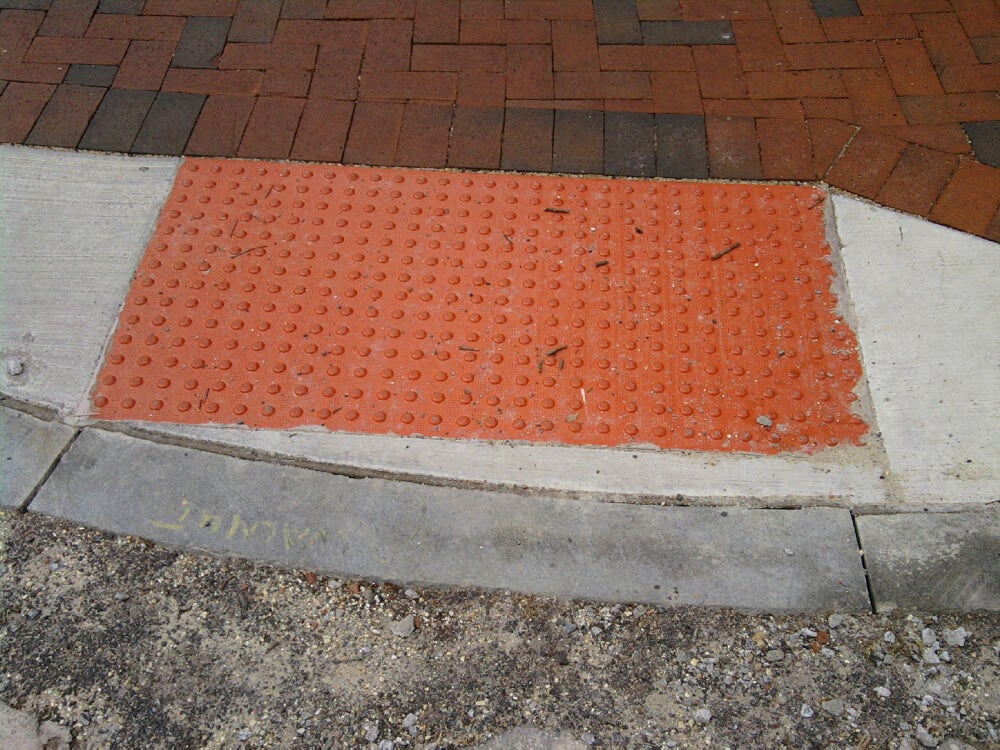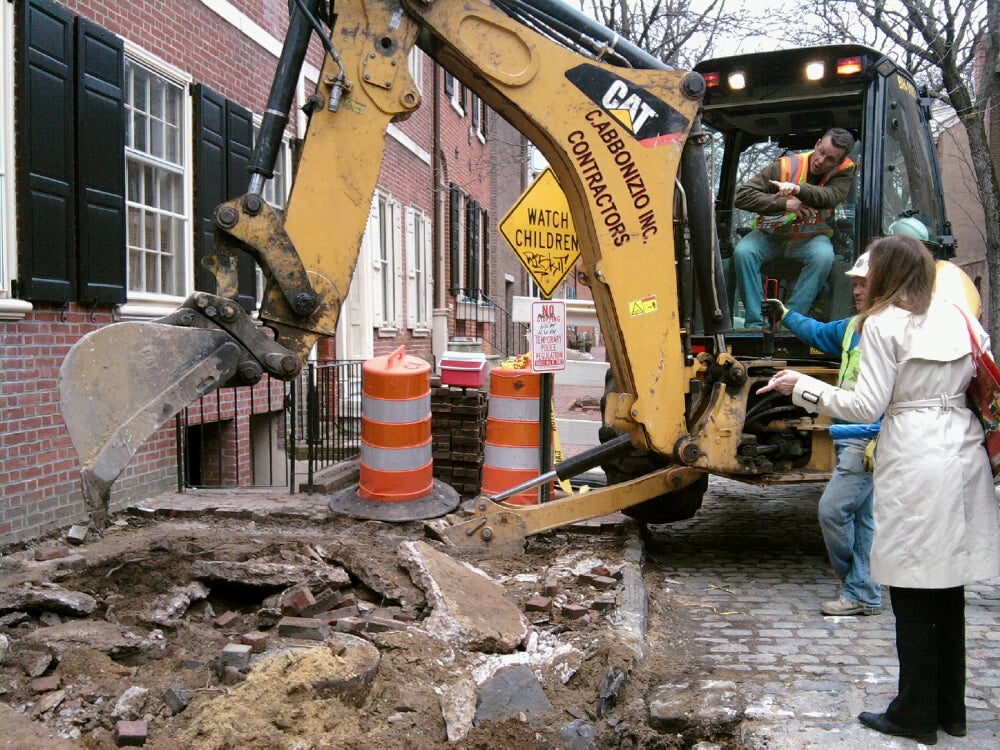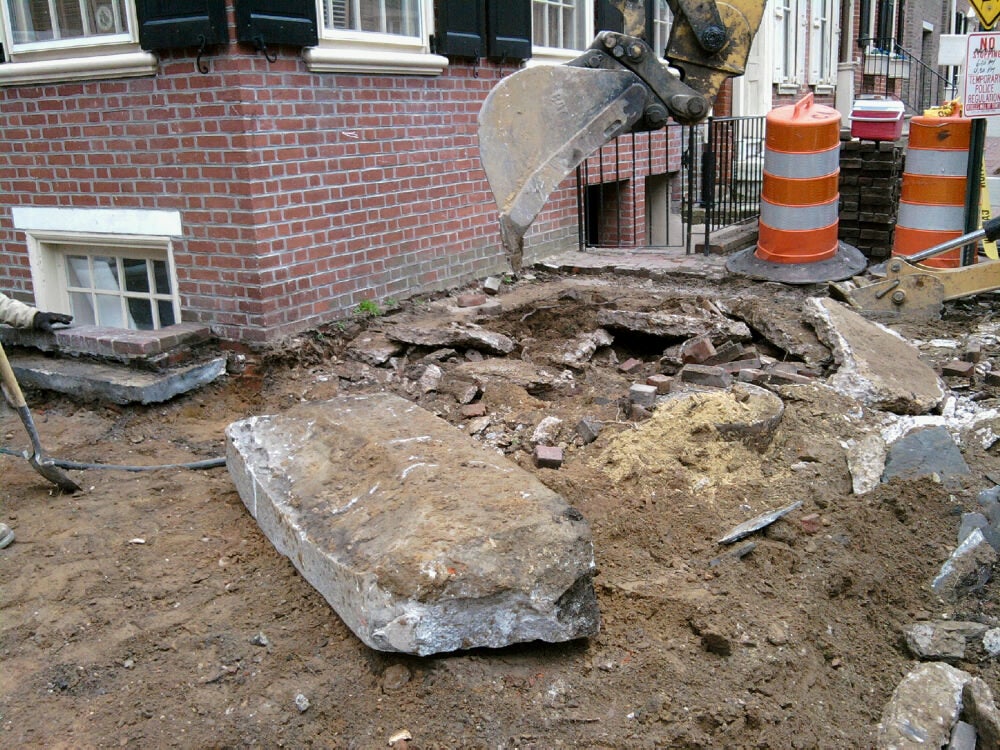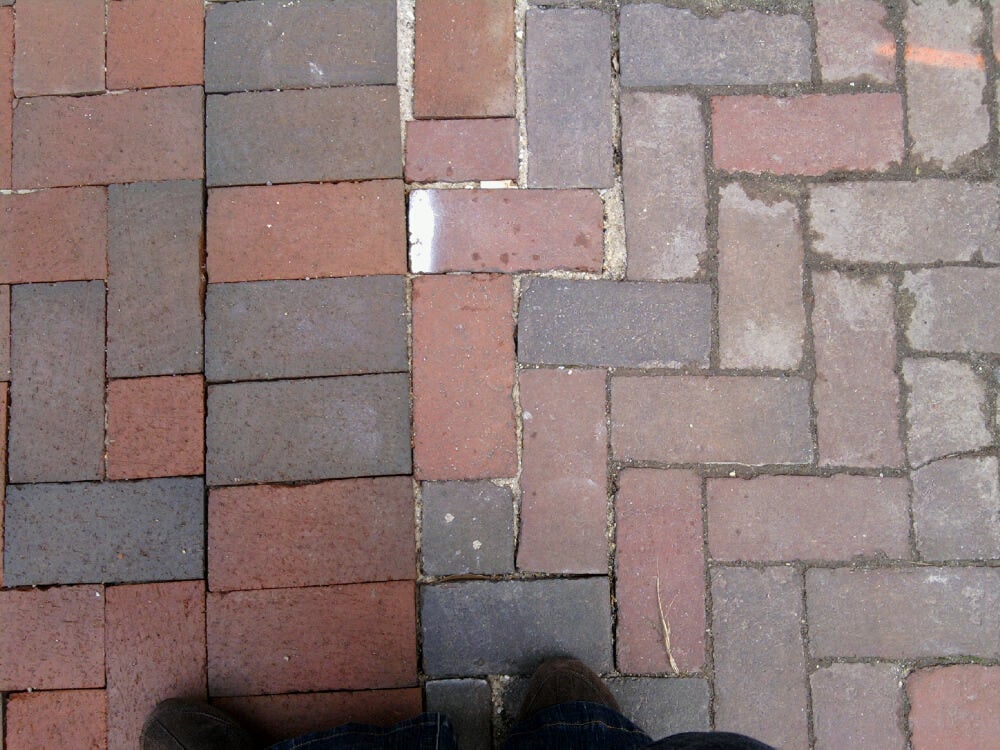ADA sidewalk ramp project raises historic preservation concerns in Society Hill
A city transportation official says work has been stopped on portions of a sidewalk improvement project that critics say threatens the historic fabric of Society Hill.
The work in question relates to the installation of handicapped accessible sidewalk ramps, made mostly of concrete but with a nubbed, fiberglass composite insert. The slope of the ramp is designed to aid people with mobility issues. The texture of these nubs – officially called truncated domes – alerts the visually impaired that they are are approaching a crosswalk.
Americans with Disabilities Act regulations that became effective in 2009 require that any street re-surfacing project include ramps built at an 8.33 percent grade, among other stringent requirements.
On some Society Hill corners, building the ramps to this grade requires lowering the level of the surrounding sidewalk. This can mean exposing a portion of a home or other structure on the corner. In some cases, the facade of the structure does not reach down as far as the new level of the sidewalk, and part of the foundation is exposed. This means additional material is needed to protect the foundation Stephen Buckley, assistant managing director for the city’s office of transportation, told PlanPhilly. And it is the concrete structures that were being installed to do this job – called cheek walls – that most concern Society Hill Civic Association and other Society Hill residents, said SHCA President Rosanne Loesch.
Representatives from Society Hill Civic, the city’s streets and law departments, and historic preservationists are working together on an alternative approach. Buckley said he is also seeking guidance from PennDOT and is asking PennDOT to get the help of the Pennsylvania Historical and Museum Commission.
The goal is to find a solution that does not harm historically important properties while conforming to Americans with Disabilities Act standards that will make traversing the neighborhood easier. The decision on how to proceed could ultimately impact other historic neighborhoods in Philadelphia and Bucks, Chester, Delaware and Montgomery counties.
Not meeting the ADA standards would put the city at risk of losing federal funding. The project extends beyond Society Hill. While not every street is slated for resurfacing at this time, the boundaries extend from Front Street to Broad and from South to Market. Of the project’s $7.55 million cost, $3.67 million is covered by federal stimulus funds.
The work starts, and residents see problems
When the sidewalk work began about two weeks ago, it was the color of the ramps and truncated domes that caught Civic Association President Loesch’s eye – both directly, and through a barrage of emails from residents. The insets were a much brighter, oranger-red and the concrete a much lighter color than what was anticipated based on a mock-up the association had approved in 2009, she said.
But it was a few days later, when two long, concrete beams were poured at the base of a home at 3rd and Delancey Streets, that Society Hill residents became very concerned that the project was going to visually mar their historic district, which is both locally and nationally recognized. The district encompasses the entire neighborhood from Walnut to Lombard streets, and from Front to 8th, with a jog slightly east of 8th to include Pennsylvania Hospital.
Loesch said the concrete structures not only radically altered the appearance of the home, but could make it difficult or impossible for the homeowners to maintain their home’s foundation and exterior walls without blasting through the concrete.
No one in Society Hill knew these structures, called cheek walls, were going to be part of the project, Loesch said. It turns out nobody involved in the process knew they would be used.
Loesch began calling city department heads and officials, and reached out to John Gallery at the Preservation Alliance for help. Gallery agreed something had to be done, and joined Society Hill Civic in asking the city for changes.
“We think that the treatment that the streets department started to use, where they had to build new concrete bases adjacent to historic houses on street corners, was detrimental to the overall Society Hill Historic district,” he said.
Historic Review
Because the project includes federal funding, which is funneled to the city via PennDOT, a review of any potential historic impact was required. That happened in 2009, when Society Hill Civic approved the colors for the concrete ramps and insets. The colors and materials were also reviewed by the city’s Historical Commission, PennDOT and the Pennsylvania Historical and Museum Commission.
“We were fine with the color and materials,” said PHMC spokesman Howard Pollman.
So was the Philadelphia Historical Commission. “The Historical Commission was shown a colored rendering of the proposed ramps,” said Commission Executive Director Jonathan Farnham. “Our response was the installation would not result in an adverse effect on the district.”
Farnham said he was not aware of the cheek walls in 2009. “I think everyone, including the city, was unaware until last week when the contractor started to install the first one,” he said.
Chuck Davies, engineer in charge of design at PennDOT’s District 6 – which includes Philadelphia and Bucks, Chester, Delaware and Montgomery counties – said only materials, not designs, were approved in 2009 because this is a design-build project. In other words, each ramp needs to be individually designed, and that happens when the project starts, and conditions on the ground are inspected by the contractor.
“It’s up to the contractor to provide that work once they are in construction, to PennDOT and to the city for review, to make sure the ramps in compliance with federal requirements regarding ADA,” Davies said.
PennDOT engineers must approve every one individually. Over the past two years, “we have built 10,000 of these ramps,” Davies said. And several hundred are in the review process at any given time.
City officials and Society Hill Civic talk ramps and cheek walls
A Wednesday morning meeting between Civic Association leaders, Buckley and other city representatives, Gallery and others was arranged by First District Councilman Frank DiCicco. The concrete and truncated dome inset issue has been solved. Buckley said in a Thursday interview that he agrees the colors on the ground are much different than those in the photo mock up approved by Society Hill Civic in 2009. It turns out the supplier sent the wrong shade of red – the shade that was used in earlier work on South Street. The right color is coming, Buckley said, and those insets already installed will be replaced at no cost to the city, he said. The concrete for the ramps will be tinted a darker color, and already-installed ramps can be stained, he said.
But Buckley said the concrete can only be so dark, because ADA requirements stipulate there must be a certain amount of contrast between the color of the ramp and the color of the insert, he said. It is important to remember, he said, that the main goal of this project is to make traveling city streets easier for everyone.
All sides continue to work on the cheek wall issue. But Loesch remained concerned Thursday that workers in her neighborhood did not understand what was supposed to happen, and that work that was supposed to stop has continued.
PlanPhilly accompanied Loesch to the work area Thursday, and Loesch was visibly shocked when a city inspector told her that the only guidance he has received concerning historic properties dealt with those of Independence National Historic Park, and was also told that all historic properties were marked with a plaque. Even for properties on the historic register, plaques are optional, and purchased by residents. So many buildings do not have them.
“I just wonder what they are doing to protect this district and the properties in it, most of which are classified as historic or contributing (to the historic district),” she said.
More on the cheek wall issue
Society Hill is not the first place where the city or PennDOT have done this work, but it is the first place where there has been a concern about the cheek walls.
Most of the state roadway resurfacing work PennDOT has done since the new ADA ramps have been required has been in more suburban locations and in Northeast Philadelphia, where there are fewer historical sites and more space to work in between the sidewalk and buildings.
A walk around Society Hill shows sidewalks marked with paint where new ramps will go and where the contractor believes cheek walls will be needed.
Buckley said the contractor has been told to stop work in all areas where cheek walls are anticipated until more information can be gathered.
He gave the Historical Commission a list of corners where new ramps are to be installed, and asked them to provide a list of all corner properties that are either individually listed on the local historic register or listed as properties that contribute to the historical nature of the district. That list was being double checked on Friday, and would likely go to the city by the end of the day, Farnham said.
Buckley said the cheek walls are not the right approach for properties that are individually listed as historical. “We didn’t have anyone who felt comfortable with that,” he said. “We believe cheek walls are not the best solution.”
A possible solution under discussion at the city is preventing the need for a protective cheek wall by extending the building’s facade downward over any foundation that would be exposed in the re-grading of the sidewalk. “When we would do this, we would need to enlist someone who does historic restorations,” Buckley said, so that the new portion of the facade would match what already exists.
Davies, the PennDOT engineer, said that so long as the solution meets ADA requirements and has sound engineering, it will likely get PennDOT’s blessing.
What about properties that are not individually listed on the historic register?
It is less certain whether cheek walls will be used at properties that are listed as contributing to the historic nature of the district or are within the district, but not listed as individually important or contributing. “Preliminarily, we do not believe that simply being in a historic district would prevent us from using cheek walls,” Buckley said.
The historical commission treats buildings that are individually listed on the register and those that are listed as contributing to the district exactly the same, Farnham said. And, he said, cheek walls would not be good for either kind of property. “I think it’s difficult to argue that these cheek walls meet historic preservation standards,” he said.
Loesch said that it seems to her any building in a historic district should be protected.
Buckley said he is not an expert on what negatively impacts a historic property, which is why he needs input from the state and local experts. Once the city has established where cheek walls can be used without a negative impact on historic properties, work will commence in those areas, Buckley said. But it will not resume in areas where a cheek wall would have a negative impact on historic property until a viable alternative is devised and given the okay by the state.
Buckley said the state historical and museum commission’s opinion will carry the day, PHMC’s Pollman said the commission acts as an advisor only, and cannot tell the city what to do. “All preservation is local,” he said.
Farnham said he is still determining whether the Historical Commission can dictate or only strongly suggest when the use of cheek walls is inappropriate. The Historical Commission asked that the street work stop when it saw that the cheek wall at 3rd and Delancey was up against the building. But Farnham said he was still trying to determine if the structure is in the city right-of-way or not.
The commission is empowered by city ordinance to do two things: Identify properties that belong on the local historic registry and review building permit applications to ensure that they meet historical preservation standards. Because the streets department does not need a building permit to do sidewalk work, in the city’s right-of-way, the commission has no official power over sidewalk issues.
That said, the streets department frequently asks for guidance, Farnham said, which is why his agency looked at the ramp mock ups. The Historical Commission also recommended that any blue stone or granite sidewalk slabs be preserved, but said that since the brick sidewalks in Society Hill were installed in the 1960s and ’70s during urban renewal projects, they were not historically important. (Loesch believes this was a very important time in her neighborhood’s history and wants the bricks to be reused. They are in some cases, but not in others.)
But if the streets department is working out of the right-of-way and across the property line of a historic building, it does need a building permit and historical commission approval to proceed, Farnham said. If it is determined the cheek walls are out of the right-of-way, “we would have the authority to say, ‘No, you can’t do that,’” Farnham said. Otherwise, the commission will rely on the power of persuasion.
Frustrated residents have told Loesch that they have to stick to strict guidelines and get historic commission approval to make changes to their homes, and the cheek walls would clearly alter the exteriors and should also require commission approval.
On site Thursday
On Thursday, work was taking place at the south west corner of 3rd and Delancey, near the first property where a cheek wall was laid.
Tony Rafael, a supervisor for contractor C. Abbonizio, demonstrated to Loesch how a cheek wall could be built at the property, and he could camouflage it with a facade of brick.
“The problem is that design decisions are being made on-site,” Loesch said. She said that the site work was begun sometime Wednesday, and that should not have happened.
Rafael said he could not just leave the foundation exposed because rain could cause problems. But he said he had been told to cease work on properties needing cheek walls. “I was told to keep going (with some parts of the project), that they are working on a solution, just don’t build any cheek walls,” he said. He said he was considering doing ramp and sidewalk work, but stopping a distance from where a cheek wall would be needed.
Buckley was determining when workers were told to stop work at cheek wall properties, but did not have the information by the end of the day Friday.
Design decisions are not being made on site, he said. Buckley said any cheek walls already installed where they are historically detrimental will be removed and the agreed upon alternative put in their place. Any exposed foundations will be covered so they are protected. And if there are any spots where pre-work eyeballing suggests no cheek wall is needed, but digging reveals that it is, those foundations, too, will be protected until the non-cheek wall solution is established.
Beyond Society Hill
In Society Hill, 2nd, 3rd, 4th, 8th, Locust, Spruce, Pine and Lombard streets are being repaved as part of this project. That translates into 142 corners where ramps will be needed. Farnham, Gallery and Loesch agree that the majority of corner properties in Society Hill are historically significant. If the city decides it can use cheek walls only on properties that are neither listed on the register individually or as contributing properties, there would still be few cheek walls in Society Hill.
In Society Hill, “We’re hoping to get all ramps and paving done this season. But obviously, we’re running into hickups we need to address,” Buckley said.
Other Philadelphia neighborhoods where work is either scheduled or is likely to take place in coming years may have more cheek walls.
Farnham’s list of historically important properties looks at blocks that are part of this project but outside of Society Hill in Washington Square West. Washington Square West is not a historic district, Farnham said, but has about 600 historically significant buildings. About 30 percent of the buildings at the corners where work is to be done are designated historically important, he said.
“Every intersection that is resurfaced has to have ADA ramps, so ultimately the entire city faces this,” Farnham said. His goal is that two important goals – accessibility and historic preservation – are honored in the process. So far, the city seems to be working toward appropriate solutions, he said, “but we still have a lot of hard work to do to find those solutions.”
The city is constantly resurfacing streets. In the past, it improved 100 to 130 miles of street per year, Buckley said. But the ADA improvements add significantly to the cost. So now, the city does 30 to 40 miles per year. “We are getting more (federal) funding. But two-thirds of the cost of resurfacing goes toward the ADA ramps,” he said. “In the past, resurfacing cost $150,000 to $200,000 per mile. Now it costs $500,000 to $700,000 per mile.”
Buckley said that his department will take the cheek wall solution eventually found for Society Hill on to other parts of the city. He is hoping to achieve a standardized, non-cheek wall approach for historic properties. Farnham said a single approach may not work, because areas are so different.
PennDOT has about 60,000 curb ramps to replace on state highways in Bucks, Chester, Delaware, Montgomery and Philadelphia counties, and approximately 25,000 of them are in Philadelphia.
Some of them will be in historically sensitive areas, and although the vast majority of projects will be financed with state money, PennDOT spokesman Gene Blaum said the state will consider potential impact on historic properties.
“We are talking about putting a check off for being in a historic area on the sheet our engineers get to review for the ramps, so they are alerted that there may be details that could potentially be problematic in an area like that,” PennDOT engineer Davies said. Other procedural changes may also arise out of the Society Hill experience, when all is said and done, he said.
Loesch said Society Hill Civic will be alerting other Philadelphia civic associations to prepare for similar work to come to their neighborhoods.
Contact the reporter at kgates@planphilly.com
WHYY is your source for fact-based, in-depth journalism and information. As a nonprofit organization, we rely on financial support from readers like you. Please give today.



